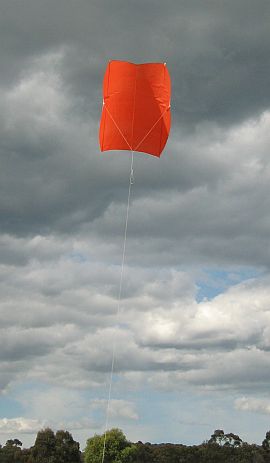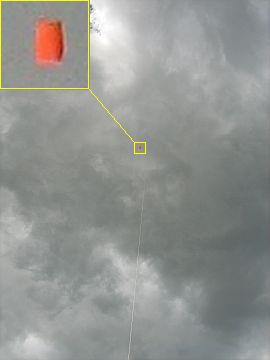- Home Page
- Simple Kites
- Simple Sled
The Simple Sled Kite
Circled Overhead in a Huge Thermal!
The Simple Sled kite seemed a reasonable choice, since wind conditions seemed very light and not overly gusty. By the way, you read the title correctly—the Simple Sled did indeed circle overhead today! There's more on that further down.
 Embarking on a very eventful flight
Embarking on a very eventful flightJust walking around for a while before getting the kite out, we could feel the sun on our necks had some bite to it. I can't remember noticing this since last summer.
Massive cumulus clouds were everywhere, blotting out the sun from time to time. The appearance of strong thermal conditions was confirmed by a small hawk. Lazily circling upwards, the bird was at around 1,000 feet above us.
On this classic "light wind and thermals" day, I was prepared to see the sled drop out of the sky from time to time. All it takes is a gust from behind or even just a big lull in the wind strength!
I took some photos with the Simple Sled kite on a fairly short line—perhaps 20 meters (70 feet) or less.
Down below treetop height there was very little consistent breeze. The bright-orange sled barely flew, staying below a 30-degree line angle most of the time. The sail collapsed often due to insufficient air pressure.
While struggling to get the kite higher, it did get caught in a ... let's call it a microthermal quite close to the ground. The kite went round in a large circle; it all happened directly overhead! That is not so common at such low altitude.
Unlike a rigid kite, a sled in freefall is just a "pile of washing." When forced to float down on its face, it tends to flatten out, slip sideways, and then roll up into an untidy bundle as it begins to plummet down. It's always a bit of a game to try to reinflate the sail in such a situation by pulling in line quickly enough—a nice feeling when you manage it, and the kite pops open before sailing back upward again!
Finally, a lengthy gust got the Simple Sled kite up much higher and into a few knots of steady wind. Flying at about 45 to 60 degrees, it was straightforward to quickly let out line to 60 meters (200 feet). There it flew for a while. Sometimes steady, sometimes changing shape in response to gustier air, the sled had the feel of a small manta ray at times!
On this site, there's more kite-making info than you can poke a stick at. :-) Want to know the most convenient way of using it all?
The Big MBK E-book Bundle is a collection of downloads—printable PDF files which provide step-by-step instructions for many kites large and small.
That's every kite in every MBK series.
So far, so good, so out went the flying line to 90 meters (300 feet)!
At this line length, the Simple Sled kite experienced one or two collapses due to lulls, but it quickly climbed back up. One of these slow dives burned through 250 feet of height before I just managed to reinflate the sail about 30 feet off the grass.
Actually, I noticed today that the kite will occasionally recover all by itself. The random nature of wind turbulence sometimes interacts with the falling pile of dowels and plastic to pop it open, parachute-like.
The wind direction was ideal for avoiding obstacles on the ground, so it was time to "max out" with 120 meters (400 feet) of flying line! Even if the kite collapsed all the way to the ground, I had a good chance of landing it in an open space of the reserve.
You might think, with all this talk of collapses, that the Simple Sled kite is hard to keep airborne. Not at all! On a day with fairly smooth air or at a coastal sea-breeze location, this kite will just hang up there and not even look like collapsing. It could be up for an hour or three, just as long as the wind blows.
 Almost out of sight, almost overhead
Almost out of sight, almost overheadAnyway, before long, the flying line tightened, and a large thermal powered the orange sled right overhead.
Check out the second photo, which shows what the camera saw with no zoom. You can just make out the flying line toward the bottom of the picture. For at least a couple of minutes, the Simple Sled kite remained overhead at 400 feet altitude—with a tight line. Fortunately, I was using our 50-pound line after having tossed up whether to try the 20-pound line since winds seemed so light!
At one stage the Simple Sled executed a big loop, pulling hard the whole time. This is not the usual scenario when you have a kite looping under excess wind speed! After dropping out of the strongest area of lifting air, the sled slowly descended to a 20-degree line angle. This probably had a lot to do with a wide area of sinking air surrounding the core of the thermal.
Since we had forgotten our sunscreen and hats, we decided to call it a day at this point. I started bringing the kite down, helped by a few more collapses in the very active air. Even after we had it down to 50 meters (170 feet) of line, it wasn't long before the Simple Sled kite was nearly overhead again.
Wind, wind, wind, wind it in.
In terms of flying fun per minute of construction time, this kite just has to be the best value of the three kites in my Simple Series! Mind you, the Simple Delta would have gone overhead today too.
The story or stories above document actual flying experiences. My write-ups are definitely "warts and all," since things don't always go totally as planned. However, half the fun of kiting is anticipating the perfect flight. When it happens, it's magic!
As mentioned earlier, there's more kite-making info here than you can poke a stick at. :-)
Want to know the most convenient way of using it all?
The Big MBK E-book Bundle is a collection of downloads—printable PDF files which provide step-by-step instructions for many kites large and small.
That's every kite in every MBK series.
